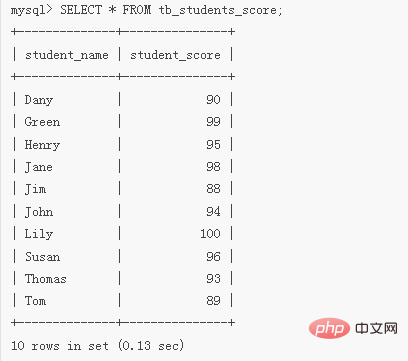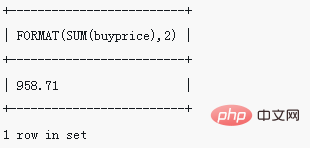How to use sum() function in mysql
In mysql, the sum() function is used to calculate the sum of a set of values or expressions. The syntax is "SUM (DISTINCT expression)". The DISTINCT operator allows calculation of different values in the set. The sum() function needs to be used together with the SELECT statement. If the SUM() function is used in a SELECT statement that does not return matching rows, the SUM() function will return NULL instead of 0; the SUM() function will ignore the columns when calculating. Rows with NULL value.

The operating environment of this tutorial: windows7 system, mysql8 version, Dell G3 computer.
mysql sum() function
The SUM() function is used to calculate the sum of a set of values or expressions. The SUM() function The syntax is as follows:
SUM(DISTINCT expression)
| Description | |
|---|---|
| expression | Required. Field or formula
- If the SUM function is used in a SELECT statement that does not return matching rows, the SUM function returns NULL instead of 0.
- The DISTINCT operator allows calculation of distinct values in a collection.
- The SUM() function ignores rows with NULL column values when calculating.
Usage example of sum() function
In order to facilitate understanding, first create a student score table tb_students_score, students The data content of the score table is as followsmysql> SELECT * FROM tb_students_score;

mysql> SELECT SUM(student_score) AS score_sum FROM tb_students_score;

Extended knowledge:
MySQL SUM and GROUP BY clause
When to use GROUP BY When clauses are combined, the SUM() function calculates the sum for each grouping specified in the GROUP BY clause. For example, you can use the SUM function with a GROUP BY clause to calculate the total amount of each order, as follows:SELECT orderNumber,
FORMAT(SUM(quantityOrdered * priceEach),2) total
FROM orderdetails
GROUP BY orderNumber
ORDER BY SUM(quantityOrdered * priceEach) DESC;+-------------+-----------+ | orderNumber | total | +-------------+-----------+ | 10165 | 67,392.85 | | 10287 | 61,402.00 | | 10310 | 61,234.67 | | 10212 | 59,830.55 | *** 此处省略了一大波数据 ***** | 10116 | 1,627.56 | | 10158 | 1,491.38 | | 10144 | 1,128.20 | | 10408 | 615.45 | +-------------+-----------+ 327 rows in set
MySQL SUM and HAVING
You can use the HAVING clause in the SUM function to filter results based on specific criteria. For example, you can calculate the total order quantity and only select orders with a total amount greater than 60,000. The following query statement-SELECT orderNumber,
FORMAT(SUM(quantityOrdered * priceEach),2)
FROM orderdetails
GROUP BY orderNumber
HAVING SUM(quantityOrdered * priceEach) > 60000
ORDER BY SUM(quantityOrdered * priceEach);
MySQL SUM and LIMIT
Suppose you want to calculate the sum of the top ten most expensive products in the products table, you can ask the following query:SELECT SUM(buyprice) FROM products ORDER BY buyprice DESC LIMIT 10;

SELECT FORMAT(SUM(buyprice),2) FROM (SELECT buyprice FROM products ORDER BY buyprice DESC LIMIT 10) price;

MySQL SUM and NULL
If there are no matching rows, the SUM function returns a NULL value. Sometimes you want the SUM function to return 0 instead of NULL. In this case, you can use the COALESCE function. The COALESCE function accepts two parameters. If the first parameter is NULL, the second parameter is returned, otherwise the first parameter is returned; refer to the following query statement:SELECT COALESCE(SUM(quantityOrdered * priceEach),0) FROM orderdetails WHERE productCode = 'S1_212121';
mysql video tutorial]
The above is the detailed content of How to use sum() function in mysql. For more information, please follow other related articles on the PHP Chinese website!

Hot AI Tools

Undresser.AI Undress
AI-powered app for creating realistic nude photos

AI Clothes Remover
Online AI tool for removing clothes from photos.

Undress AI Tool
Undress images for free

Clothoff.io
AI clothes remover

Video Face Swap
Swap faces in any video effortlessly with our completely free AI face swap tool!

Hot Article

Hot Tools

Notepad++7.3.1
Easy-to-use and free code editor

SublimeText3 Chinese version
Chinese version, very easy to use

Zend Studio 13.0.1
Powerful PHP integrated development environment

Dreamweaver CS6
Visual web development tools

SublimeText3 Mac version
God-level code editing software (SublimeText3)

Hot Topics
 MySQL: An Introduction to the World's Most Popular Database
Apr 12, 2025 am 12:18 AM
MySQL: An Introduction to the World's Most Popular Database
Apr 12, 2025 am 12:18 AM
MySQL is an open source relational database management system, mainly used to store and retrieve data quickly and reliably. Its working principle includes client requests, query resolution, execution of queries and return results. Examples of usage include creating tables, inserting and querying data, and advanced features such as JOIN operations. Common errors involve SQL syntax, data types, and permissions, and optimization suggestions include the use of indexes, optimized queries, and partitioning of tables.
 MySQL's Place: Databases and Programming
Apr 13, 2025 am 12:18 AM
MySQL's Place: Databases and Programming
Apr 13, 2025 am 12:18 AM
MySQL's position in databases and programming is very important. It is an open source relational database management system that is widely used in various application scenarios. 1) MySQL provides efficient data storage, organization and retrieval functions, supporting Web, mobile and enterprise-level systems. 2) It uses a client-server architecture, supports multiple storage engines and index optimization. 3) Basic usages include creating tables and inserting data, and advanced usages involve multi-table JOINs and complex queries. 4) Frequently asked questions such as SQL syntax errors and performance issues can be debugged through the EXPLAIN command and slow query log. 5) Performance optimization methods include rational use of indexes, optimized query and use of caches. Best practices include using transactions and PreparedStatemen
 Why Use MySQL? Benefits and Advantages
Apr 12, 2025 am 12:17 AM
Why Use MySQL? Benefits and Advantages
Apr 12, 2025 am 12:17 AM
MySQL is chosen for its performance, reliability, ease of use, and community support. 1.MySQL provides efficient data storage and retrieval functions, supporting multiple data types and advanced query operations. 2. Adopt client-server architecture and multiple storage engines to support transaction and query optimization. 3. Easy to use, supports a variety of operating systems and programming languages. 4. Have strong community support and provide rich resources and solutions.
 How to connect to the database of apache
Apr 13, 2025 pm 01:03 PM
How to connect to the database of apache
Apr 13, 2025 pm 01:03 PM
Apache connects to a database requires the following steps: Install the database driver. Configure the web.xml file to create a connection pool. Create a JDBC data source and specify the connection settings. Use the JDBC API to access the database from Java code, including getting connections, creating statements, binding parameters, executing queries or updates, and processing results.
 How to start mysql by docker
Apr 15, 2025 pm 12:09 PM
How to start mysql by docker
Apr 15, 2025 pm 12:09 PM
The process of starting MySQL in Docker consists of the following steps: Pull the MySQL image to create and start the container, set the root user password, and map the port verification connection Create the database and the user grants all permissions to the database
 MySQL's Role: Databases in Web Applications
Apr 17, 2025 am 12:23 AM
MySQL's Role: Databases in Web Applications
Apr 17, 2025 am 12:23 AM
The main role of MySQL in web applications is to store and manage data. 1.MySQL efficiently processes user information, product catalogs, transaction records and other data. 2. Through SQL query, developers can extract information from the database to generate dynamic content. 3.MySQL works based on the client-server model to ensure acceptable query speed.
 Laravel Introduction Example
Apr 18, 2025 pm 12:45 PM
Laravel Introduction Example
Apr 18, 2025 pm 12:45 PM
Laravel is a PHP framework for easy building of web applications. It provides a range of powerful features including: Installation: Install the Laravel CLI globally with Composer and create applications in the project directory. Routing: Define the relationship between the URL and the handler in routes/web.php. View: Create a view in resources/views to render the application's interface. Database Integration: Provides out-of-the-box integration with databases such as MySQL and uses migration to create and modify tables. Model and Controller: The model represents the database entity and the controller processes HTTP requests.
 How to install mysql in centos7
Apr 14, 2025 pm 08:30 PM
How to install mysql in centos7
Apr 14, 2025 pm 08:30 PM
The key to installing MySQL elegantly is to add the official MySQL repository. The specific steps are as follows: Download the MySQL official GPG key to prevent phishing attacks. Add MySQL repository file: rpm -Uvh https://dev.mysql.com/get/mysql80-community-release-el7-3.noarch.rpm Update yum repository cache: yum update installation MySQL: yum install mysql-server startup MySQL service: systemctl start mysqld set up booting




%20function%20in%20mysql)


